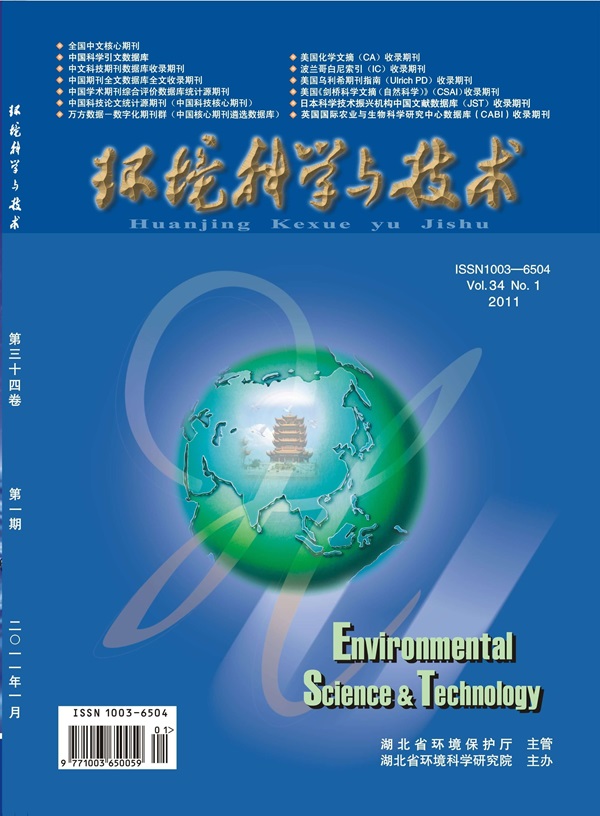太阳界面水蒸发过程中挥发性有机化合物去除的表面氧空位工程
IF 10.8
1区 环境科学与生态学
Q1 ENGINEERING, ENVIRONMENTAL
引用次数: 0
摘要
太阳界面的水蒸气转化已经成为一种很有前途的清洁水生产方法,特别是在缺水地区,但一个主要的挑战是挥发性有机化合物(voc)和水蒸气一起,导致冷凝水被污染。本研究介绍了一种新的设计策略,该策略利用光催化剂中的表面氧空位(OVs)来最大限度地利用空气中的氧(O2)和光载体在空气-水界面的效率,基于先前的研究表明,界面上的氧浓度可以显著高于大量水中的氧浓度。通过增强氧吸附和促进载流子分离,OVs显著提高活性氧(ROS,包括·O2 -和·OH)的生成和整体光催化活性。作为演示,与传统系统相比,表面ovs设计的基于biocl的光催化太阳能界面蒸发器的VOC(苯酚)去除效率提高了3.41倍,在冷凝水中实现了超过99.6%的VOC去除率,并保持了1.90 kg/m2/h的高水蒸气生成通量。使用zno基光催化剂进一步验证了这一创新设计,证明了ov工程在界面系统中的广泛适用性。通过充分利用空气-水界面的高氧含量和光载流子动力学的改善,该方法代表了光催化水处理技术的重大进步,为VOC去除和清洁水生产提供了可扩展和高效的解决方案。本文章由计算机程序翻译,如有差异,请以英文原文为准。

Surface Oxygen Vacancy Engineering for Enhanced Volatile Organic Compounds Removal in Solar-Interfacial Water Evaporation
Solar-interfacial water-vapor conversion has emerged as a promising method for clean water production, particularly in water-scarce regions, but a major challenge is the volatile organic compounds (VOCs) along with water vapor, leading to polluted condensed water. This study introduces a novel design strategy that leverages surface oxygen vacancies (OVs) in photocatalysts to maximize both oxygen (O2) utilization from the air and photocarrier efficiency at the air–water interface, building upon previous research that demonstrated that oxygen concentration at the interface can be significantly higher than that in bulk water. By enhancing oxygen adsorption and facilitating charge carrier separation, OVs significantly improve reactive oxygen species (ROS, including ·O2– and ·OH) generation and overall photocatalytic activity. As a demonstration, the surface OVs-engineered BiOCl-based photocatalytic solar interfacial evaporator demonstrated a 3.41-fold increase in VOC (phenol) removal efficiency compared to a conventional system, achieving over 99.6% VOC removal in condensed water and maintaining a high water vapor generation flux of 1.90 kg/m2/h. This innovative design was further validated using ZnO-based photocatalysts, demonstrating the broad applicability of OV-engineering in interfacial systems. By fully utilizing both the high oxygen content at the air–water interface and improving photocarrier dynamics, this approach represents a significant advancement in photocatalytic water treatment technologies, offering a scalable and highly efficient solution for VOC removal and clean water production.
求助全文
通过发布文献求助,成功后即可免费获取论文全文。
去求助
来源期刊

环境科学与技术
环境科学-工程:环境
CiteScore
17.50
自引率
9.60%
发文量
12359
审稿时长
2.8 months
期刊介绍:
Environmental Science & Technology (ES&T) is a co-sponsored academic and technical magazine by the Hubei Provincial Environmental Protection Bureau and the Hubei Provincial Academy of Environmental Sciences.
Environmental Science & Technology (ES&T) holds the status of Chinese core journals, scientific papers source journals of China, Chinese Science Citation Database source journals, and Chinese Academic Journal Comprehensive Evaluation Database source journals. This publication focuses on the academic field of environmental protection, featuring articles related to environmental protection and technical advancements.
 求助内容:
求助内容: 应助结果提醒方式:
应助结果提醒方式:


